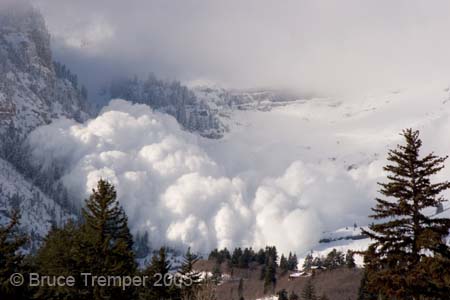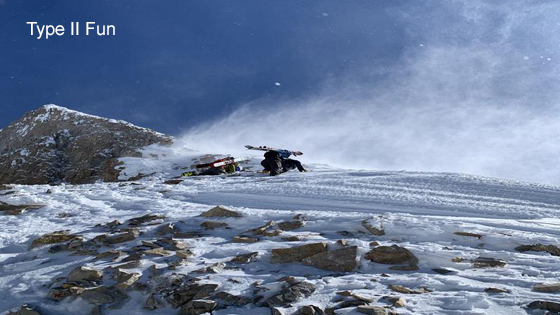Mount Timpanogos Winter Safety
Be very clear on this: given half a chance, Timp will kill you. Many of the people who have died on Mt. Timpanogos in recent decades have died in the winter, usually because of avalanches. Each and every person who refused to spend the time and money to buy a beacon, probe, and shovel, to take at least an Avalanche 1 course and a Rescue course, and to study the Utah Avalanche Center avalanche forecasts regularly, has died or will die. To avoid suffocating in an icy tomb, begin by watching this video:
Yes, You Will Die
 There are many things to do on Mount Timpanogos during the winter that are relatively safe: downhill skiing at the Sundance Mountain Resort; cross country skiing at the Sundance Nordic Center, the Aspen Grove Family Camp, or along the Little Mill trail in American Fork Canyon; or snowshoeing near trailheads. However, there are also things to do on Timp during the winter that are very dangerous. Going high on the mountain without the proper gear and training is the one of them. Mt. Timpanogos gets cold, and will freeze you if you aren’t bundled up. However, most people know to bundle up to avoid hypothermia. Many people, though, either don’t realize that Timp routinely releases massive avalanches, or they figure they’ll just roll the dice and hope they avoid one. You are going to die. If you prefer that to happen late in your life, don’t go high on the mountain in the winter without first having gotten a beacon, probe, and shovel, taken at least an Avalanche 1 course and a Rescue course, and regularly studied the Utah Avalanche Center’s avalanche forecasts. Make sure that your travel partners have done so as well; someone needs to know how to find you under the snow, and dig you out. Also, don’t assume that staying off avalanche prone slopes will keep you safe—you need to beware of runout zones as well. The photo on the right, from the Utah Avalanche Center’s web site, provides an educational example of that fact. It is of a naturally released avalanche that dropped for thousands of feet off of Elk Point before running out across the flats by Aspen Grove.
There are many things to do on Mount Timpanogos during the winter that are relatively safe: downhill skiing at the Sundance Mountain Resort; cross country skiing at the Sundance Nordic Center, the Aspen Grove Family Camp, or along the Little Mill trail in American Fork Canyon; or snowshoeing near trailheads. However, there are also things to do on Timp during the winter that are very dangerous. Going high on the mountain without the proper gear and training is the one of them. Mt. Timpanogos gets cold, and will freeze you if you aren’t bundled up. However, most people know to bundle up to avoid hypothermia. Many people, though, either don’t realize that Timp routinely releases massive avalanches, or they figure they’ll just roll the dice and hope they avoid one. You are going to die. If you prefer that to happen late in your life, don’t go high on the mountain in the winter without first having gotten a beacon, probe, and shovel, taken at least an Avalanche 1 course and a Rescue course, and regularly studied the Utah Avalanche Center’s avalanche forecasts. Make sure that your travel partners have done so as well; someone needs to know how to find you under the snow, and dig you out. Also, don’t assume that staying off avalanche prone slopes will keep you safe—you need to beware of runout zones as well. The photo on the right, from the Utah Avalanche Center’s web site, provides an educational example of that fact. It is of a naturally released avalanche that dropped for thousands of feet off of Elk Point before running out across the flats by Aspen Grove.
Sitting through a one hour avalanche presentation at REI, or studying KBYG information online, or reading an avalanche book by Bruce Tremper or Allen & Mike may be a good start, but is not a substitute for also investing in an Avy 1 course and a Rescue course (although the KBYG web site is pretty amazing). Between the Avy 1 and Rescue courses, and the avalanche safety gear, you may be out some money. Just bite the bullet, and do it. Funerals cost more.
There are a number of books on Wasatch ski touring, and there are various ski touring-specific maps, to give you ideas about where to go. If you run across the Facebook page created to allow local backcountry skiers to partner up for trips, you’ll notice that you can’t even join that group unless you’ve completed formal avalanche training. Because no one wants to die because of someone else’s cluelessness.
Apart from general information on avalanche safety from the Utah Avalanche Center and from Avalanche.org, there are plenty of good AIARE Avy 1 courses to choose from all through the winter (there are also AAI courses). In addition, sign up to have the free Utah Avalanche Center’s daily avalanche forecasts on Provo area mountains emailed to you, and read them daily even though you usually won't be going out every day. You’ll learn a lot from following those reports over time.
If you are one of the few with enough sense and fortitude and training to travel somewhat safely in winter backcountry, here are examples of what awaits you on Timp:
Special Additional Content
For strange and unknown reasons, some people may think that the content of this web page is bleak. No, and indeed your humble webmaster is known for his positively effervescent and relentlessly uplifting nature. But to make sure your visit ends on a high note, here are some inspirational videos:
Last updated on the first day of 2025, during a week in which there were two separate avalanche fatalities elsewhere in Utah.

